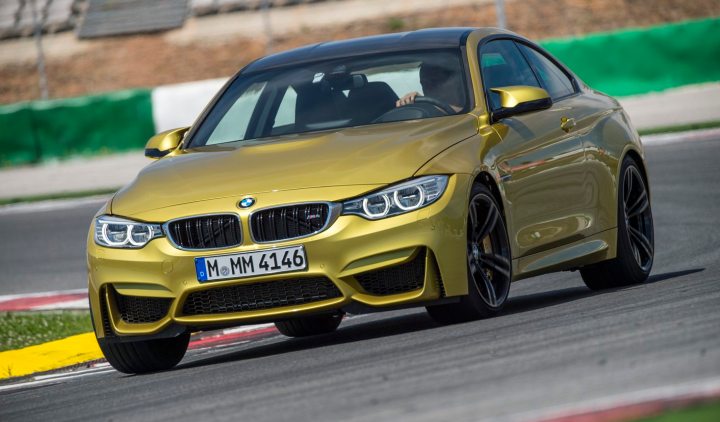Maverick Life
BMW M4 Coupé: Master blaster

Purist petrolheads have been up in arms ever since it emerged that BMW’s latest-generation M3 and M4 would swap the traditional high-revving, normally aspirated power plant for a smaller turbocharged alternative. But as it turns out, there was never any reason for concern: the new M4 delivers a performance car master class. By DEON SCHOEMAN.
It’s a crisp, clear winter’s morning on the Highveld. The temperature is hovering at just above freezing, but parked right in the middle of the Kyalami racing circuit’s Second Ess, there’s nothing cold about the Austin Yellow BMW.
The car in question exudes an unmistakable aura of performance, expressed not only by the way the sheet metal seems stretched tautly over the wide, muscle-rippling frame, but also by the wheel arch-filling alloy wheels, the fat-footprint Michelin rubber, and the snarl of the cooling apertures below the trademark kidney grilles.
This is the new BMW M4, or more specifically, the coupé version of the latest-generation M3. The Bavarian marque’s decision to designate even model numbers to all its two-door cars (2-Series, 4-Series, 6-Series) means that the two-door M-car now wears the M4 badge, while its four-door sibling retains the M3 designation.

Mechanically, the two cars are identical, but there’s no doubt that the M4 we’ve spirited away for a few early-morning hours ahead of the scheduled media launch is the more dramatic, more overtly athletic machine.
The basic shape remains recognisably 4-Series, but the M-treatment transforms the two-door into something altogether more menacing. From the carbon fibre-reinforced plastic roof to the aero-shaped mirrors, from the purposeful cooling ducts to the quadruple exhausts, you can almost taste the testosterone.
But what’s also instantly apparent is that the M4 is by no means a small car. At 4,67m long, 1,87m wide and 1,38m tall, it’s actually bigger than the E28-generation BMW M5 I piloted around this very track in the late 1980s. And while the new M4 is around 80kg lighter than the previous E92 M3, it’s still 37kg than that original M5, too …

That M5 was a wicked car, as I found out when I flung it into the Kylami Esses too early, and exited the second sideways, with almost no tar to spare – a white-knuckle moment born of youthful brazenness and a singular lack of experience. Back then, a power-to-weight ratio of 147 kW/ton was a lot of urge to manage ….
The new M4 is not only bigger than that original M5, but also a lot more powerful. In some ways, there’s something classically familiar about the 3.0-litre straight-six now lurking under that long, swooping bonnet: the E46 M3, perhaps one of the name plate’s all-time greats, used a similar cylinder configuration, albeit with a slightly bigger 3.2-litre capacity.
But there’s one major difference: the M4’s mill is twin-turbocharged, and benefits from two generations’ worth of advanced technology. The result is 317kW of maximum urge, and a fat 550Nm torque peak. Compare that to the E46 M3’s 252 kW – or, for that matter the E28 M5’s 210 kW from its 3.5-litre straight-six power plant …

Transmissions have also moved on significantly. Delivering the M4’s urge to the rear wheels is a seven-speed dual-clutch gearbox that punches through the ratios with all the percussive enthusiasm of a purebred racing ‘box. Yes, you can opt for a six-speed manual, but even that gearbox will auto-blip the throttle on downshifts, making old-style heel-and-toe cog swaps an unnecessary art.
But for all its impressive technology, its careful aerodynamic management and its weight-saving measures through the use of lightweight materials, the real proof of the performance pudding is in the driving. And besides, it’s likely to be a lot warmer inside the M4’s snug cabin!
And snug it is: the wide-opening doors allow easy access to contoured, race-inspired, hard-backed bucket seats that cosset your frame in supportive comfort from every angle. The ergonomics, however, are familiar 3-Series/4-Series territory: a grippy steering wheel framing clear controls, shift paddles for the dual-clutch gearbox, and the iDrive controller in the centre console providing intuitive access to vehicle systems and configurations.

In the M4, everything is tinged with an M-inspired brush: the M-logo is applied to instruments and gearlever, and the steering wheel’s stitching is in the traditional red and blue of the M-division. But it’s testimony to the efficient design of the standard 4-Series cabin that the essence of the M4’s interior remains unchanged.
A start button wakes up the big-six mill up front, and as soon as you hear the deep, sonorous thrum of the engine, any concerns that a turbo engine will be lacking in character and thrills are instantly, emphatically dispelled.
It’s a sound that’s hard to quantify: there’s an initial throatiness that’s more V8 than straight-six, but as the revs rise, the sound’s crescendo is definitely more six than eight. And don’t let anyone tell you that a turbo engine sounds muted, or can’t pile on the revs …

Okay, so the previous M3’s V8 could be chased into 8,000rpm territory, while the new engine will run into the red at around 7,300rpm – but that’s still spinning fast. And while the soundtrack is certainly different, it’s no less stirring, even if it’s partly synthesised.
Feed the six-cylinder some 95 octane, and the you get a first, rapid introduction to what makes this M4 tick. And the key word is torque. Big, fat dollops of torque. You get shoved back into that high-backed seat while the car relentlessly gathers momentum.
With the DCT gearbox, there’s almost no let-up in urge between gear shifts, while your instinct is to short-change, simply because all that shove seems unsustainable across the rev range. But it is, and if you keep your right foot planted, the sensation is almost brutal in its speed and persistence.

The engine’s appetite for revs, while dishing out torque and muscle, creates a dynamic character unlike any previous M3 or M4. It’s both effortless and insistent, with a sledgehammer effect that blurs the surroundings and brings up corners much, much quicker than expected.
At Kyalami, it starts with the pit exit and an immediate jostle to the right in an attempt to get to apex so that the car can be lined up properly for the double left-hander that follows. It’s a mark of just how quickly the M4 gather speed that you have to brake hard, properly hard, ino the second part of the corner.
Sunset beckons with its invitation to turn in too early, so I leave the wheels straight, before cranking the wheel right hard and deep into the turn, and feeding in the power gently as we approach the apex. But there’s nothing gentle about the way the M4 squirms and squiggles, and gathers speed – I’m in Clubhouse and gearing down with real intent before I realise it.

The Esses (my almost-nemesis in the M5 all those years ago) follow, and by now I’m wise to just how rapidly everything happens in the M4. The traction control light flickers constantly in the lower gears as the control electronics fight the constant surge of urge, and I’m grateful that the DCT musters shifts faster than I’d ever mange with a manual ‘box.
The steering is a revelation. Although electrically assisted, it’s been calibrated to react with impressive heft and finesse. There’s no sign of edgy over-assistance, and combined with the chassis’ eager, direct communication, there’s never any doubt about where the M4 is on the track or, how it’s reacting to driver input.
As before, those reactions can be tailored: steering, shift speed, suspension damping and throttle response are all adjustable, as is the intervention of the dynamic stability control system. The preferred combination of settings can then be stored, and recalled instantly at the push of a button on the steering wheel.

At its most lenient setting, the stability control will allow the M4’s rear to slide progressively into controllable oversteer up to a point – a sensation that comes as an initially unexpected but welcome surprise in the context of usually carefully modulated modern cars.
Of course, you can also switch all assistance off, but be warned: the M4 is not a car to be dallied with in the absence of that electronic safety net: that twin-turbo punch is simply to brutal, too instantaneous, to master without some extended wheel time …
In fact, it’s that tsunami of torque that is the dominating aspect of the M4. It turns the car into a performance sledgehammer that needs to be wielded with car, but that delivers such astonishing midrange torque and tractability that it quickly becomes intoxicating.

Does that mean the M4 has lost some of the finely honed finesse that has always been a highlight of successive M3 generations? Is this a car commanded purely by the punch of its forced-induced engine?
With only a few hours of track time, that’s hard to say: time spent on the road, in real-world conditions, will provide a more conclusive answer. But it’s clear that the M4 (and, I would assume, it’s mechanically identical M3 sedan stablemate) has set the performance bar a good few notches higher.
And that certainly goes as much for the chassis as it does for the engine. The new car is stiffer and lighter, the assistance systems quicker and more progressive, the steering direct and precise without disconnecting the driver from the experience.

But by the same token, the margins for error are slimmer, and the reliance on the vehicle’s considerable assistance system arsenal a lot higher. And even then, it’s an unruly car when pressing on …
As an example of automotive performance technology, the M4 shines with unrelenting brightness. It’s going to be a sports car slayer of epic proportions, with the ability to eclipse some pretty fancy machinery, while still offering four-seater comfort and a decent boot.
In that context, even the price isn’t exorbitant: with a base price of (just) below R1-milliion, what else out there offers this level of dynamic excellence, technological sophistication, practicality and pure, heart-stopping, driving excitement? Nissan’s GT-R? The immortal Porsche 911?

The Nissan will be quicker, yes. The Porsche the purer thoroughbred sports car. But in overall terms, with all aspects considered, the best package might just be the BMW. It’s that good. DM
|
|
BMW M4 Coupé M-DCT |
|
|
|
|
Engine |
In-line six-cylinder, 2,979cc, twin-turbo |
|
Gearbox |
Seven-speed M-DCT |
|
Power |
317kW @ 5,500rpm |
|
Torque |
550Nm @ 1,850rpm |
|
0-100 km/h |
4.1 sec |
|
Top speed |
250km/h (governed) |
|
Fuel consumption |
8.3 litres/100km (tested) |
|
CO2 emissions |
194g/km |
|
Retail price/ as tested |
R997,500 / R1,283,692 |


















 Become an Insider
Become an Insider